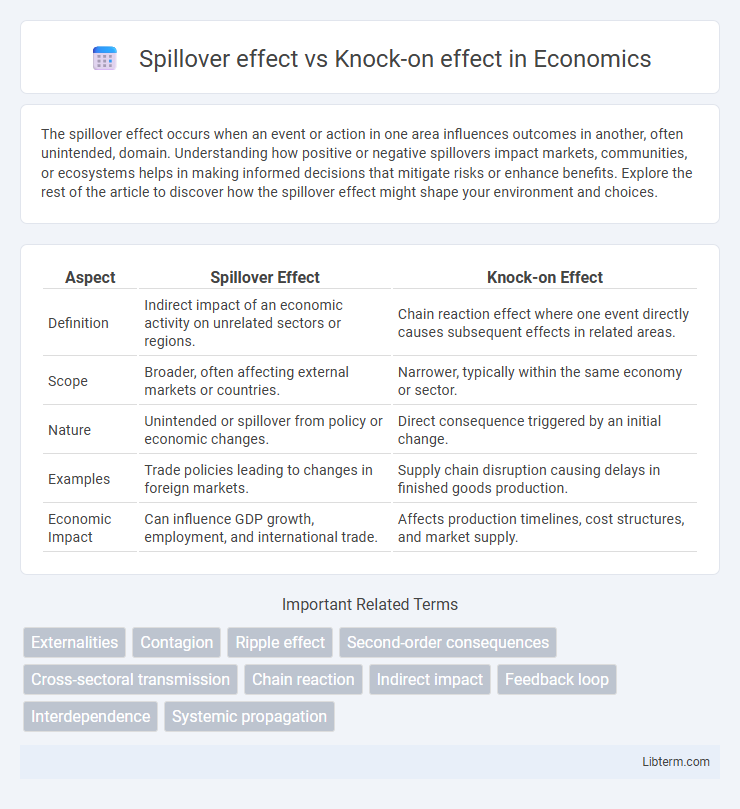The spillover effect occurs when an event or action in one area influences outcomes in another, often unintended, domain. Understanding how positive or negative spillovers impact markets, communities, or ecosystems helps in making informed decisions that mitigate risks or enhance benefits. Explore the rest of the article to discover how the spillover effect might shape your environment and choices.
Table of Comparison
| Aspect | Spillover Effect | Knock-on Effect |
|---|---|---|
| Definition | Indirect impact of an economic activity on unrelated sectors or regions. | Chain reaction effect where one event directly causes subsequent effects in related areas. |
| Scope | Broader, often affecting external markets or countries. | Narrower, typically within the same economy or sector. |
| Nature | Unintended or spillover from policy or economic changes. | Direct consequence triggered by an initial change. |
| Examples | Trade policies leading to changes in foreign markets. | Supply chain disruption causing delays in finished goods production. |
| Economic Impact | Can influence GDP growth, employment, and international trade. | Affects production timelines, cost structures, and market supply. |
Understanding Spillover Effect: Definition and Context
The spillover effect refers to the indirect impact that an economic event or policy in one area has on another, often unintended and extending beyond the original context. It commonly occurs in international trade, environmental issues, and public health, where actions in one country or sector cause repercussions elsewhere. Understanding spillover effects is crucial for policymakers to anticipate and manage cross-border or cross-sectoral consequences effectively.
What is Knock-on Effect? A Clear Explanation
The knock-on effect refers to a chain reaction where an initial event causes a series of subsequent events, each triggered by the previous one, leading to widespread impact. It often occurs in economic contexts, such as a disruption in supply chains causing delays and increased costs across multiple industries. This ripple effect highlights how interconnected systems can transmit consequences beyond the original point of impact.
Key Differences: Spillover Effect vs Knock-on Effect
The spillover effect refers to the impact of an economic, social, or environmental event in one region or sector that indirectly influences another, often beyond its immediate boundaries. The knock-on effect describes a chain reaction where an initial event triggers subsequent events in a sequential manner, causing a ripple throughout connected systems. Key differences lie in the spillover effect's broader, less direct influence across different areas, while the knock-on effect emphasizes a direct, sequential progression within interrelated elements.
Common Similarities Between Spillover and Knock-on Effects
Spillover effects and knock-on effects both describe situations where an initial event causes subsequent impacts beyond its original context, influencing other sectors or regions. They share the characteristic of indirect consequences that can amplify economic, social, or environmental outcomes across interconnected systems. These effects emphasize the importance of understanding ripple dynamics in policy-making and strategic planning to anticipate broader implications.
Examples of Spillover Effect in Economics and Society
The spillover effect in economics occurs when the actions of one agent inadvertently impact others, such as pollution from factories affecting public health and property values. In society, educational improvements in one community often lead to higher employment rates and reduced crime in neighboring areas. These examples highlight how economic activities or social changes extend beyond their immediate context, generating broader benefits or costs.
Illustrative Cases of Knock-on Effects in Real Life
Knock-on effects refer to the indirect consequences triggered by an initial event, creating a chain reaction in interconnected systems. In real life, the 2011 Japan earthquake demonstrated a knock-on effect where the tsunami damaged nuclear reactors, leading to widespread power outages and economic disruptions. Similarly, the global supply chain crisis during the COVID-19 pandemic revealed how factory shutdowns in one country led to material shortages and production delays worldwide.
Mechanisms Driving Spillover Effects
Spillover effects occur when economic activities or shocks in one region or sector indirectly impact others through interconnected markets, supply chains, or labor mobility. Mechanisms driving spillover effects include knowledge transfer, capital flows, and changes in consumer demand, which amplify the initial impact beyond the origin. Understanding these pathways is critical for policymakers aiming to enhance regional growth or mitigate negative externalities from economic disruptions.
How Knock-on Effects Influence Decision Making
Knock-on effects significantly influence decision making by revealing the chain reactions triggered by initial actions or events, allowing decision-makers to anticipate and mitigate unintended consequences. Understanding these cascading impacts enables leaders to prioritize resource allocation and risk management more effectively. This foresight aids in crafting strategies that account for secondary and tertiary outcomes, improving overall organizational resilience.
Measuring Impact: Assessing Spillover vs Knock-on Effects
Measuring the impact of spillover versus knock-on effects requires distinct approaches focused on their scope and transmission pathways. Spillover effects capture indirect consequences that extend beyond the immediate target area, often observed in economic, environmental, or social contexts through cross-sectoral data analysis. Knock-on effects concentrate on sequential outcomes within a defined chain of events, assessed by modeling cause-and-effect relationships to quantify cumulative impacts over time.
Policy Implications: Managing Unintended Consequences
Spillover effects in policy refer to unintended impacts of an intervention that extend beyond the targeted area or population, requiring comprehensive assessment to avoid negative outcomes in adjacent sectors. Knock-on effects describe a chain reaction of secondary impacts triggered by a primary policy action, necessitating robust scenario planning and adaptive management strategies. Effective policy design incorporates systematic evaluation of both spillover and knock-on effects to mitigate unintended consequences and enhance overall governance outcomes.
Spillover effect Infographic

 libterm.com
libterm.com